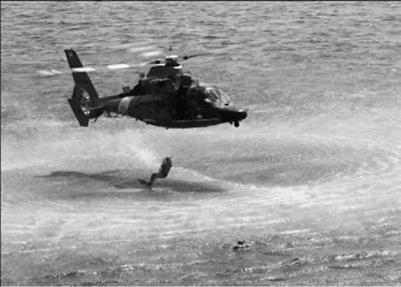Ground Effect
The induced velocity of a rotor in hover is considerably influenced by the near presence of the ground. At the ground surface the downward velocity in the wake is, of course, reduced to zero and this effect is transferred upwards to the disc through pressure changes in the wake, resulting in a lower induced velocity for a given thrust. This is shown in Figures 2.30 and 2.31.
The two images illustrate the wake impinging on the water during air sea rescue operations. The outward motion of the waves shows how the vertical velocity at the rotor disc is turned to a horizontal direction by the effect of the sea. The induced power is therefore lower, which is to say that a helicopter at a given weight is able to hover at lower power thanks to ‘support’ given by the ground. Alternatively put, for a given power output, a helicopter ‘in ground effect’ is able to hover at a greater weight than when it is away from the ground. As Bramwell has put it, ‘the improvement in performance may be quite remarkable; indeed some of the earlier, underpowered, helicopters could hover only with the help of the ground’.
The theoretical approach to ground effect is, as would be expected, by way of an image concept. A theory by Knight and Hafner [11] makes two assumptions about the normal wake:
|
|
|
Figure 2.31 Hovering close to water surface showing wake impingement (Courtesy US Navy) |
1. That circulation along the blade is constant, thus restricting the vortex system to the tip
vortices only.
2. That the helical tip vortices form a uniform vortex cylinder reaching to the ground.
The ground plane is then represented by a reflection of this system, of equal dimensions below the plane but of opposite vorticity, ensuring zero normal velocity at the surface. The induced velocity at the rotor produced by the total system of real and image vortex cylinders is calculated and hence the induced power can be derived as a function of rotor height above the ground.
It is found that the power, expressed as a proportion of that required in the absence of the ground, is as low as 0.5 when the rotor height to rotor radius is about 0.4, a typical value for the point of take-off. Since induced power is roughly two-thirds of total power (Section 2.1), this represents a reduction of about one-third in total power. By the time the height to radius ratio reaches 2.0, the power ratio is close to 1.0, which is to say ground effect has virtually disappeared. The results are only slightly dependent on the level of thrust coefficient.
Similar results have been obtained from tests on model rotors, measuring the thrust that can be produced for a given power. A useful expression emerges from a simple analysis made by Cheeseman and Bennett [12], who give the approximate relationship:
|
|
where T is the rotor thrust produced in ground effect and T1 is the rotor thrust produced out of ground effect at the same level of power. Z is the rotor height above the ground and R is the rotor radius. The variation is shown in Figure 2.32.
|
Z / R Figure 2.32 Ground effect on rotor thrust |
This shows good agreement with experimental data.
Ground effect has a profound influence on a helicopter’s performance and so a technical specification will often include two values for a quantity such as power or thrust either in ground effect (IGE) or out of ground effect (OGE).


















